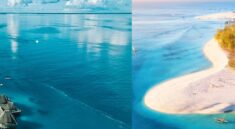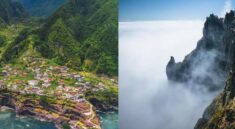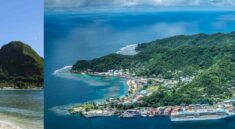Reine is a picturesque fishing village located in the Lofoten archipelago in Norway. This charming village is renowned for its stunning natural beauty, with dramatic mountain landscapes and crystal-clear waters. Reine is a popular destination for tourists and outdoor enthusiasts seeking to explore the rugged landscapes of the Lofoten Islands. Some of the highlights of Reine and the surrounding area include fishing, hiking, photography, and the opportunity to experience traditional Norwegian culture. The village of Reine is a perfect base for exploring the breathtaking scenery of the Lofoten Islands and offers a tranquil and immersive experience in the heart of Norway’s natural wonders.
How to get there
Reine, a picturesque fishing village in the Lofoten Islands of Norway, is a remote destination known for its stunning natural beauty. To get to Reine, you’ll typically need to travel to the Lofoten archipelago first, and then make your way to the village itself. Here’s how to get there:
1. Fly to Lofoten:
- The most common way to reach Reine is by air. You can book a flight to Leknes Airport (LKN) or Svolvær Airport (SVJ), which are the two main airports in the Lofoten Islands. Both airports have domestic flights from Oslo and other major Norwegian cities. Leknes Airport is closer to Reine than Svolvær Airport.
2. Drive or Take a Bus:
- Once you arrive at Leknes or Svolvær Airport, you can rent a car if you plan to explore the Lofoten Islands independently. Alternatively, you can take a bus to the village of Reine. Bus routes and schedules may vary, so it’s advisable to check with the local transportation authorities for the most up-to-date information.
3. Ferry from Bodø:
- Another option, especially if you’re traveling from the mainland of Norway, is to take a ferry from Bodø to the Lofoten Islands. Bodø is well-connected to other parts of Norway by train and air. The ferry ride offers scenic views of the archipelago and provides an enjoyable travel experience.
4. Consider a Tour:
- If you prefer a hassle-free experience or are not comfortable navigating the Lofoten Islands on your own, you can book guided tours that include transportation to Reine and other popular destinations in the area. These tours often provide insight into local culture and history.
5. Check Seasonal Variations:
- Keep in mind that travel options and schedules may vary depending on the season. Some routes and services are more frequent in the summer months when tourism is at its peak.
6. Plan Ahead:
- Reine is a small village, and accommodations can fill up quickly, especially during the high season. It’s advisable to book your accommodations well in advance if you plan to stay in Reine.
7. Enjoy the Scenic Journey:
- The journey to Reine is part of the experience, as you’ll be surrounded by stunning landscapes, towering mountains, and picturesque fjords. Be sure to take in the breathtaking scenery along the way.
Whether you choose to fly, take a ferry, or drive to Reine, you’ll be rewarded with the natural beauty and tranquility of this remote and idyllic village in the Lofoten Islands of Norway.
Things to do
Reine and the surrounding Lofoten Islands offer a wealth of outdoor activities and natural beauty to explore. Here are some of the top things to do when visiting Reine:
- Hiking: The Lofoten Islands are a hiker’s paradise. You can explore numerous hiking trails that offer breathtaking views of the rugged coastline, fjords, and mountains. Popular hikes in the area include Reinebringen, Munkebu Hut, and Ryten.
- Photography: The stunning landscapes of Reine and the Lofoten Islands make it a photographer’s dream. Capture the dramatic mountains, colorful fishing cabins (rorbuer), and the interplay of light and shadows, especially during the midnight sun and Northern Lights seasons.
- Fishing: Engage in traditional fishing activities by booking a fishing excursion or trying your luck from the shore or a rented boat. The Lofoten Islands are known for their rich fishing heritage.
- Kayaking: Explore the crystal-clear waters and hidden coves of the Lofoten fjords by renting a kayak or joining a guided kayak tour. Paddling in these pristine waters is a unique experience.
- Northern Lights Viewing: If you visit during the winter months, don’t miss the chance to witness the Northern Lights (Aurora Borealis). Reine’s dark skies and northern location provide excellent opportunities for Northern Lights sightings.
- Explore Reine: Stroll through the charming village of Reine, known for its iconic red and yellow fishing cabins (rorbuer). Visit the local shops, galleries, and cafes, and immerse yourself in the traditional Norwegian culture.
- Visit Å: Drive or take a short bus ride to the village of Å, the southernmost settlement in the Lofoten Islands. Explore the Lofoten Stockfish Museum and experience the history of the region.
- Bird Watching: The Lofoten Islands are home to diverse bird species, making it an ideal location for birdwatching. Keep an eye out for seabirds like puffins and white-tailed eagles.
- Beach Activities: Relax on one of the area’s beautiful beaches, such as Bunes Beach or Ramberg Beach. You can also try your hand at surfing or simply enjoy the serene coastal scenery.
- Cruise or Boat Tour: Consider taking a boat tour or a fishing excursion to explore the fjords and nearby islands. These tours often provide opportunities for wildlife sightings and offer unique perspectives of the landscape.
- Sample Local Cuisine: Savor fresh seafood and traditional Norwegian dishes at local restaurants and eateries. Lofoten is known for its cod and stockfish dishes.
- Camping: If you’re an outdoor enthusiast, camping in the Lofoten Islands is a rewarding experience. There are designated camping areas, and you can enjoy the unique sensation of camping under the midnight sun during the summer.
Remember that the activities you can enjoy in Reine may vary depending on the season, so it’s essential to plan your visit accordingly. Whether you’re seeking outdoor adventures, cultural experiences, or simply a peaceful retreat in nature, Reine and the Lofoten Islands offer something for every traveler.
Things not to forget
When visiting Reine and the Lofoten Islands, it’s important to be well-prepared for your adventure, as the region is known for its rugged terrain and changing weather conditions. Here’s a list of essential items and things not to forget when exploring this beautiful part of Norway:
- Weather-Appropriate Clothing: The weather in the Lofoten Islands can be unpredictable. Pack layers of clothing, including waterproof and windproof outerwear, a warm jacket, moisture-wicking clothing, gloves, and a hat. Be prepared for both cold and wet conditions.
- Sturdy Footwear: Comfortable and waterproof hiking boots with ankle support are essential for exploring the trails and rugged terrain. Ensure they are broken in before your trip to prevent blisters.
- Backpack: A sturdy and comfortable backpack is crucial for carrying essentials like water, snacks, extra clothing, and gear during your hikes.
- Navigation Tools: Bring a detailed map of the area, a compass or GPS device, and a charged mobile phone with a map app. GPS can be particularly helpful in case of fog or low visibility.
- Safety Gear: Include safety essentials such as a headlamp with extra batteries, a basic first-aid kit, a whistle, and a multi-tool in your backpack.
- Water and Snacks: Stay hydrated by carrying a sufficient supply of water (at least 2-3 liters per person). Pack high-energy snacks like trail mix, energy bars, and dried fruits for sustenance during hikes.
- Emergency Blanket: Carry an emergency space blanket or bivvy in case of unexpected weather changes or emergencies.
- Communication: Keep a fully charged mobile phone with you, but conserve battery by using it in airplane mode. Inform someone you trust about your hiking plans and expected return time.
- Cash: Some remote areas in the Lofoten Islands may have limited access to ATMs and card payments. Carry some cash for emergencies or small purchases.
- Reusable Water Bottle: Reduce waste by carrying a reusable water bottle, which you can refill at various locations.
- Travel Documents: Have your identification, any required permits, travel insurance information, and a copy of important documents in a waterproof pouch.
- Trash Bags: Practice Leave No Trace principles by packing out all your waste, including food wrappers and used tissue.
- Insect Repellent: During the summer months, mosquitoes can be present, so insect repellent can be useful.
- Personal Medications: If you have any prescription medications or specific medical needs, ensure you have an adequate supply.
- Camera and Accessories: Don’t forget your camera or smartphone for capturing the stunning scenery, and bring extra batteries or a portable charger.
- Swimwear: If you plan to swim in the crystal-clear waters, have swimwear and a towel handy.
- Local Information: Familiarize yourself with local regulations, weather forecasts, and trail conditions before heading out.
- Tide Schedule: If you plan to explore coastal areas, check the tide schedule to ensure your safety and avoid getting stranded.
Best time to visit
The best time to visit Reine and the Lofoten Islands in Norway depends on your interests and what you hope to experience during your trip. Here’s a breakdown of the different seasons and what they offer:
- Summer (June to August):
- Best for Hiking and Midnight Sun: Summer is the peak tourist season in the Lofoten Islands. The weather is relatively mild, with temperatures ranging from 10°C to 20°C (50°F to 68°F). This is the best time for hiking, as most trails are snow-free and accessible. You can also experience the midnight sun, with 24 hours of daylight in June and July.
- Wildlife Sightings: Summer is a great time for birdwatching and observing wildlife, as many species are active during this season.
- Fall (September to October):
- Fall Colors: This season brings beautiful fall foliage as the landscape transitions to vibrant shades of red, orange, and yellow. The weather is still relatively mild, with temperatures averaging around 8°C to 14°C (46°F to 57°F).
- Northern Lights: As the nights grow longer, you have a chance to see the Northern Lights (Aurora Borealis) again, especially toward the end of the season.
- Winter (November to February):
- Northern Lights: The winter months offer the best opportunities to witness the Northern Lights. With longer nights and clearer skies, you can enjoy stunning displays of the auroras.
- Snow Activities: If you’re a fan of winter sports like skiing, snowboarding, or snowshoeing, this is the time to visit. However, be prepared for colder temperatures, ranging from -2°C to 4°C (28°F to 39°F) on average.
- Spring (March to May):
- Early Spring Hiking: As the snow begins to melt, you can start hiking some of the lower-elevation trails, though higher trails may still be covered in snow.
- Whale Watching: Spring marks the beginning of the whale-watching season in the Lofoten Islands, with opportunities to spot orcas and humpback whales.
Is Reine worth visiting?
Yes, Reine is a must-visit destination in Norway. Its unparalleled natural beauty, stunning landscapes, and unique cultural experiences make it a worthwhile destination for travelers seeking adventure, photography opportunities, and a taste of traditional Norwegian life.
What is Reine Norway known for?
Reine, Norway, is known for its stunning natural beauty, characterized by majestic mountains, crystal-clear fjords, and iconic red and yellow fishing cabins (rorbuer). It’s a renowned destination for outdoor enthusiasts, hikers, and photographers seeking captivating landscapes and a taste of traditional Norwegian fishing culture.
How do you get to Reine Norway?
To reach Reine, Norway, you typically follow these steps:
- Fly: Book a flight to one of the main airports serving the Lofoten Islands, such as Leknes Airport (LKN) or Svolvær Airport (SVJ). Both airports have connections to major Norwegian cities like Oslo and Tromsø.
- Drive or Take a Bus: After arriving at the airport, you can rent a car for the drive to Reine. Alternatively, take a bus to Reine or nearby towns. Bus routes and schedules may vary, so it’s essential to check with local transportation authorities.
- Ferry from Bodø: If you’re traveling from mainland Norway, consider taking a ferry from Bodø to the Lofoten Islands. Bodø is accessible by train, bus, and plane. The ferry ride provides scenic views of the archipelago.
- Plan Your Accommodations: Reine is a small village, and accommodations can fill up quickly, especially during the high season. It’s advisable to book your lodging well in advance if you plan to stay in Reine.
What is the history of Reine?
Reine, a picturesque village in the Lofoten Islands of Norway, has a rich history tied to fishing and the rugged natural landscape. Here’s a brief history of Reine:
- Fishing Heritage: Reine has a strong fishing heritage dating back centuries. Traditional fishing activities, including cod fishing, were the primary livelihoods of the local population. Historic fishing cabins called “rorbuer” provided shelter for fishermen during their fishing expeditions.
- Cod Liver Oil Production: In addition to fish, Reine was historically known for its production of cod liver oil, which was an essential export. Cod liver oil was extracted from cod livers and used for medicinal purposes.
- Growth as a Village: Over time, Reine grew into a small but vibrant fishing village, characterized by its distinctive red and yellow fishing cabins and its scenic location by the sea.
- Tourism: In recent decades, tourism has become increasingly important for Reine’s economy. The village’s stunning natural beauty, hiking opportunities, and cultural experiences have drawn visitors from around the world.
- Conservation Efforts: Reine and the Lofoten Islands are known for their commitment to preserving the environment and maintaining sustainable fishing practices. Efforts have been made to protect the fragile ecosystems while supporting the local economy.
Today, Reine continues to be a charming and thriving village where traditional fishing culture coexists with tourism, offering a unique blend of history, natural beauty, and cultural experiences for visitors to enjoy.
Image credits: img.peapix.com





